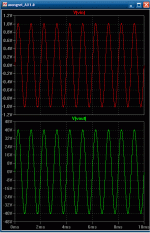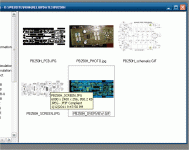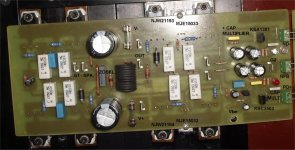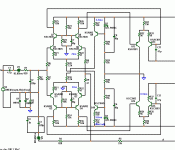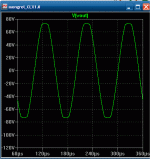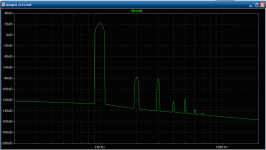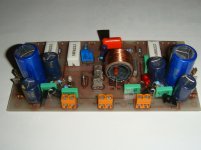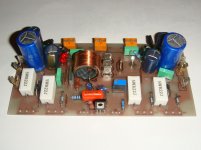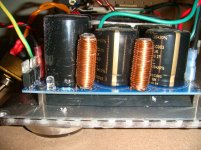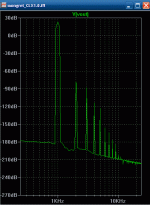yes it will help me to understand i dont learn fast but I make some progress .. merci beaucoup
Thank you OS for those datas. This gives a benchmark of the performances to beat. 😉
Merci beaucoup.
Merci beaucoup.
While we're demystifying things.....
I've been looking at the AX/BX schematics just trying to make sure I understand everything (!) and realized I have no clue about the capacitance C3//C4. Looks to me like the purpose is to "AC couple" the feedback. I'm new at this, but I've read through Slone and Cordell, and I don't recall seeing this in either book.
So what's the deal ? Is it to keep feedback from screwing with the (precisely tuned to zero) DC offset ?
I've been looking at the AX/BX schematics just trying to make sure I understand everything (!) and realized I have no clue about the capacitance C3//C4. Looks to me like the purpose is to "AC couple" the feedback. I'm new at this, but I've read through Slone and Cordell, and I don't recall seeing this in either book.
So what's the deal ? Is it to keep feedback from screwing with the (precisely tuned to zero) DC offset ?
While we're demystifying things.....
I've been looking at the AX/BX schematics just trying to make sure I understand everything (!) and realized I have no clue about the capacitance C3//C4. Looks to me like the purpose is to "AC couple" the feedback. I'm new at this, but I've read through Slone and Cordell, and I don't recall seeing this in either book.
So what's the deal ? Is it to keep feedback from screwing with the (precisely tuned to zero) DC offset ?
The AC voltage gain of the amplifier is 1+R5/R4.
C3/C4 keep the DC gain equal to 1 to keep the amplifier from amplifying any DC offset.
While we're demystifying things.....
I've been looking at the AX/BX schematics just trying to make sure I understand everything (!) and realized I have no clue about the capacitance C3//C4. Looks to me like the purpose is to "AC couple" the feedback. I'm new at this, but I've read through Slone and Cordell, and I don't recall seeing this in either book.
So what's the deal ? Is it to keep feedback from screwing with the (precisely tuned to zero) DC offset ?
Solids accessment is "solid" ... 😀
(below plot 1) is the 40X gain of the AX/BX. {Plot 2} is the DC rolloff (green) of the blocking caps (C3/4) resulting in 0 DB gain at .2HZ at the output (RED).
I have "flopped" my woofers with my synthesizers at 2 HZ with -3db output. So these amps have a range of 2hz - 100Khz (-3db). 🙂
OS
Attachments
Measurements
I have not located where the actual measurement data is. Could you please show me the way.
I have heard them at their home. I know the sim'd results are backed up by actual measurements by others.
I look forward to experiencing them in my home when they are available.
I have not located where the actual measurement data is. Could you please show me the way.
I have not located where the actual measurement data is. Could you please show me the way.
Boy , I wish I had a $10K AP distortion analyzer. 🙂
To put this to rest , The "blameless" design is a very common one , both the AX/BX are based on it. This design is absolutely the most measured and documented of all the topologies. Read "Audio Power Amplifier Design Handbook - D. Self " any edition , or "Bob Cordell - Designing Audio Power Amplifiers" ... and you will see this circuit with all of it's data.
Self's "take" on this design is basic and actually measures with lower than average THD , Cordell's version is more like my AX and performs to a even higher degree. I add capacitance multipliers , a cascode , and high performance input pairs to cordell's design. On top of that , the AX has TMC , further reducing the remaining distortion mechanisms. The PB power stages are also "fine tuned" to the AX/BX, giving inaudible noise and hum and a large "first watt" as explained a few posts back.
With such a simple design , not much can go wrong. Performance would follow the rules of simple physics and the choice of components. I don't make enough money to afford expensive test equipment ... but the testing has already been done for me. 😎
OS
Hallo!
First of all I would like to say that it is a pleasure to read this thread! Since weeks I have come here and enjoy the progress and diskussion about amps, electronics and sound. Thank you for all this!
Now I am planning to build this amplifier, because it seems to me (noob) one (the?) of the best sounding diy amplifiers.
Since now I learned that some devices beginning with 2sc... can be found easier under KSA/KSC. So all parts could be bought from mouser in europe. (I'm thankful for every advice where to buy or which parts better to buy!)
From my diy speaker project (Duetta ADW mine looks a bit different, it's a one piece design) I learned that a capacitor is a mysterious thing because 4.7uF from one manufacturer can sound different to 4.7uF from another. 😕
And now, to cut a long story short, my question:
Do you have any recommendations for C1-C9 for the AX1.3VB and the Cs in the PowerBoard?
PS:
And another question:
I could read between the lines that the AX sounds "best". I am looking for a amp which comes the ideal amp ("a wire with amplification") the closest, but it should not only be as neutral as possible but also be able to deliver the soul of the music, so to make fun to listen to it! Is the AX the best amp for me, or have I to wait for the LX, or do I have to build a completely different amp? 😉
Greetings
Matthias
First of all I would like to say that it is a pleasure to read this thread! Since weeks I have come here and enjoy the progress and diskussion about amps, electronics and sound. Thank you for all this!
Now I am planning to build this amplifier, because it seems to me (noob) one (the?) of the best sounding diy amplifiers.
Since now I learned that some devices beginning with 2sc... can be found easier under KSA/KSC. So all parts could be bought from mouser in europe. (I'm thankful for every advice where to buy or which parts better to buy!)
From my diy speaker project (Duetta ADW mine looks a bit different, it's a one piece design) I learned that a capacitor is a mysterious thing because 4.7uF from one manufacturer can sound different to 4.7uF from another. 😕
And now, to cut a long story short, my question:
Do you have any recommendations for C1-C9 for the AX1.3VB and the Cs in the PowerBoard?
PS:
Os, do you have any results of your amps? Which one measures the best?Os: ...but the testing has already been done for me
And another question:
I could read between the lines that the AX sounds "best". I am looking for a amp which comes the ideal amp ("a wire with amplification") the closest, but it should not only be as neutral as possible but also be able to deliver the soul of the music, so to make fun to listen to it! Is the AX the best amp for me, or have I to wait for the LX, or do I have to build a completely different amp? 😉
Greetings
Matthias
Hallo!
Is the AX the best amp for me, or have I to wait for the LX, or do I have to build a completely different amp? 😉
Greetings
Matthias
If you wait a week or two OS will have another amp for you to consider! Then - a couple of weeks after that - - - - - - - - - another..... 😀😀😀😀
Fortunately they are not expensive to play with after you get past the cost of having some spare transformers and heatsinks to prototype with. 😉
PB250H "my baby".... documentation done.
I have been putting it off , just sharing bits and pieces. The "best" of the modular power output boards is done (below 1). It is in the mongrel root as "PB250H.ZIP". I had to take my wires off to photograph it for the package (below 2).
This is the PB I do my final high power tests on. I have had the AX , BX , and GX , each running for a month or more , this nice piece of fr-4. After the voltage stages get a test run on the new PB-60X2 , they get the final "audition" here.
The BOM's are verbose. The best guidelines are to derate (100V caps) , low ESR. I use Nichicon , panasonic (excellent - from mouser) exclusively. Xicon and Dale power resistors. The only "made in china" part is the blue led.
The "AX" is the first one I will sell as a completed , fully integrated amp (Voltage stage -120W power stage- PS ... all in one) I will order 100 pro boards once I ABSOLUTELY perfect it 110% (I'm REAL close to that).
I have no regret's (I am satified - completely) on the PB250H layout. With the excellent NJW21193/4's and 20mm rail traces (soldered a 10mm copper bar all the way down them - like Nico Ras's "big booty amp" 😀) this PB is truly a "wire with gain". With these OP devices , 400w/4R is well within the SOA (DC SOA @ 65V is almost 10A w/ 4 devices) safety margin of this amp.
Yes I will , now that I "caught up" , I will design the (hopefully)excellent "CLX"
(below 3). It will only cost me 15$ for a pair to hook to my PB60/250's. Yeah , it is nice to not have to rebuild the power stage everytime !! 😎😎
OS
I have been putting it off , just sharing bits and pieces. The "best" of the modular power output boards is done (below 1). It is in the mongrel root as "PB250H.ZIP". I had to take my wires off to photograph it for the package (below 2).
This is the PB I do my final high power tests on. I have had the AX , BX , and GX , each running for a month or more , this nice piece of fr-4. After the voltage stages get a test run on the new PB-60X2 , they get the final "audition" here.
By murdoc- Do you have any recommendations for C1-C9 for the AX1.3VB and the Cs in the PowerBoard?
The BOM's are verbose. The best guidelines are to derate (100V caps) , low ESR. I use Nichicon , panasonic (excellent - from mouser) exclusively. Xicon and Dale power resistors. The only "made in china" part is the blue led.
The "AX" is the first one I will sell as a completed , fully integrated amp (Voltage stage -120W power stage- PS ... all in one) I will order 100 pro boards once I ABSOLUTELY perfect it 110% (I'm REAL close to that).
I have no regret's (I am satified - completely) on the PB250H layout. With the excellent NJW21193/4's and 20mm rail traces (soldered a 10mm copper bar all the way down them - like Nico Ras's "big booty amp" 😀) this PB is truly a "wire with gain". With these OP devices , 400w/4R is well within the SOA (DC SOA @ 65V is almost 10A w/ 4 devices) safety margin of this amp.
By C2Cthomas - If you wait a week or two OS will have another amp for you to consider! Then - a couple of weeks after that - - - - - - - - - another.....
Yes I will , now that I "caught up" , I will design the (hopefully)excellent "CLX"
(below 3). It will only cost me 15$ for a pair to hook to my PB60/250's. Yeah , it is nice to not have to rebuild the power stage everytime !! 😎😎
OS
Attachments
Hi OS,
INDEED IT WILL BE !!! with output LAFETS ... yes, its a pity that for me is SO DIFFICULT and $$$ to obtain good components, but as you I try do the best I can ...
Cheers
Arturo
Yes I will , now that I "caught up" , I will design the (hopefully)excellent "CLX"
(below 3). It will only cost me 15$ for a pair to hook to my PB60/250's. Yeah , it is nice to not have to rebuild the power stage everytime !!
INDEED IT WILL BE !!! with output LAFETS ... yes, its a pity that for me is SO DIFFICULT and $$$ to obtain good components, but as you I try do the best I can ...
Cheers
Arturo
Hi , artu. I hope you don't think my "version" of your killer amp is the joke of the day. My simulator tells a different story. Mine stays at .001% to .002% THD, ALL the way from 100hz to 40khz. This is short of the "AX" , but the distortion spectra and clipping characteristic's are what I'm after. Below (pix 1 - 10k FFT)
and (pix 2 - clipping). I'm satisfied with the 100V+/uS slew as well with my 47R/47pF degeneration and compensation.
This amp is really a blend of tilbrook's aes6000 and the leach amp. I foresee it as a good subwoofer amp because of the well behaved clipping. It may also sound very good because it's spectra looks more like a single ended amp (the BX) , so I may like it to drive my new speakers (tweeters and midrange's) as well.
OS
and (pix 2 - clipping). I'm satisfied with the 100V+/uS slew as well with my 47R/47pF degeneration and compensation.
This amp is really a blend of tilbrook's aes6000 and the leach amp. I foresee it as a good subwoofer amp because of the well behaved clipping. It may also sound very good because it's spectra looks more like a single ended amp (the BX) , so I may like it to drive my new speakers (tweeters and midrange's) as well.
OS
Attachments
Having trouble with PB120N
The 2200uf caps are too big to fit in the provided space on the board. I've had to relocate the surrounding caps on longer leads and bend them out of the way to get everything to fit as well as redrill some holes for the caps.
It should work ok but looks a bit untidy.
The 2200uf cap is only 18mm diameter, which is the smallest available.
Also the silk screen for C85/86 and C87/88 are reversed.
Just letting you know as you mentioned putting an order in for pro pcb's
Pete
The 2200uf caps are too big to fit in the provided space on the board. I've had to relocate the surrounding caps on longer leads and bend them out of the way to get everything to fit as well as redrill some holes for the caps.
It should work ok but looks a bit untidy.
The 2200uf cap is only 18mm diameter, which is the smallest available.
Also the silk screen for C85/86 and C87/88 are reversed.
Just letting you know as you mentioned putting an order in for pro pcb's
Pete
Attachments
Its actually air brake line for trucks. I used double sided tape and wrapped the wire over it.
I did the same method on the coils on the psu.
Ahh! Don't mention water in Brisbane. Have you seen the news of the floods we are going through at the moment.
I did the same method on the coils on the psu.
Ahh! Don't mention water in Brisbane. Have you seen the news of the floods we are going through at the moment.
Attachments
Last edited:
Hi OS, No man seriously, you are going a great job, no doubt that the AX, BX series and the new CLX are among the best of the best. You are right about the spectra, it doesn't matter a high H2, what matters is low and few Hn ->, ... is what I am pursuing by years ...
Cheers
Arturo
Cheers
Arturo
The 2200uf caps are too big to fit in the provided space on the board. I've had to relocate the surrounding caps on longer leads and bend them out of the way to get everything to fit as well as redrill some holes for the caps.
It should work ok but looks a bit untidy.
The 2200uf cap is only 18mm diameter, which is the smallest available.
Also the silk screen for C85/86 and C87/88 are reversed.
Just letting you know as you mentioned putting an order in for pro pcb's
Pete
First you have the big diodes where the small diodes should be(d98/99 =big). You can use 63 V caps for this PB. Also 47uF can be used for the small electrolytics and 1kuf can be the big ones. At 2 X 47u the cap multipliers will still emulate 4700u with a transistor beta of 100+. Thanks , I will review the 120 "package". 😱
OS
Hi OS, No man seriously, you are going a great job, no doubt that the AX, BX series and the new CLX are among the best of the best. You are right about the spectra, it doesn't matter a high H2, what matters is low and few Hn ->, ... is what I am pursuing by years ...
Cheers
Arturo
I try , with limited resources. In fact , I am amazed I've gotten to this point. My R and D system works pretty good now. First build it (voltage stage) , plug it in to the PB60X2. This is where the CRO is , voltage and signal checks to see how close to the simulation I am , AND the first audible test with my small Sony speakers and a portable MP3 player.
After I am satisfied to the operating points (especially VAS current) , I can directly swap the new voltage stages into the PB250's ... I usually "burn in" for a day before this. As far as the "best of the best" , I have only built most of the AB DIY here at the forum. Among those , these rule in the quality vs. simplicity arena. The CLX will have 14 or even 16 devices (2Q CCS ??) , more than the "blameless" , but that does not scare me. I should be a very "mirror image" layout.
Yes , At 1K ..this topology even shows this "musical" harmonic structure in a grand way (below). It seems to be the only design to do this .. the leach is good at cancelling even harmonic components , but this one cancels even/odd the same. Some would say you could not discern any audible difference , or that, (in general) a fully complimentary amp can not sound as good as a single ended one. I say they will not be advancing the cause by having such a "closed train" of thought. 🙁
OS
Attachments
Last edited:
Hi OS,
Musicality is another open issue for all kinds of design. There are the 'goods' harmonics (what constitutes music) and the 'bads' harmonics (injected by the device), and FB works in a two fold way, linearising (fidelity) and mixing all of them in "the juicer" (the signal circulates and transformed in an endless round robin, the 'memory effect' of FB loops).
So a bad amp despite it's 'apparently' good or reasonable numbers will sound 'bad' (a pasted sound with no resolution) and other with more modest ratings can sound 'better' (brilliance, lyrics ... many subjective adjectives).
This is what Hugh Dean claims that many dismisses. Mi opinion is that obtaining a FFT profile where harmonics are low enough and monotonically fade out is the best, the discernment is real even if the levels are not individually heard and the brain indeed doest it (a very complex and sophisticated machine). So music reproduction is very much on how you "feel" it. I believe that this topology bring us the best of both, fidelity and musicality.
Cheers
Arturo
Yes , At 1K ..this topology even shows this "musical" harmonic structure in a grand way (below). It seems to be the only design to do this .. the leach is good at cancelling even harmonic components , but this one cancels even/odd the same. Some would say you could not discern any audible difference , or that, (in general) a fully complimentary amp can not sound as good as a single ended one. I say they will not be advancing the cause by having such a "closed train" of thought.
Musicality is another open issue for all kinds of design. There are the 'goods' harmonics (what constitutes music) and the 'bads' harmonics (injected by the device), and FB works in a two fold way, linearising (fidelity) and mixing all of them in "the juicer" (the signal circulates and transformed in an endless round robin, the 'memory effect' of FB loops).
So a bad amp despite it's 'apparently' good or reasonable numbers will sound 'bad' (a pasted sound with no resolution) and other with more modest ratings can sound 'better' (brilliance, lyrics ... many subjective adjectives).
This is what Hugh Dean claims that many dismisses. Mi opinion is that obtaining a FFT profile where harmonics are low enough and monotonically fade out is the best, the discernment is real even if the levels are not individually heard and the brain indeed doest it (a very complex and sophisticated machine). So music reproduction is very much on how you "feel" it. I believe that this topology bring us the best of both, fidelity and musicality.
Cheers
Arturo
- Home
- Amplifiers
- Solid State
- The MONGREL (supersym II)
